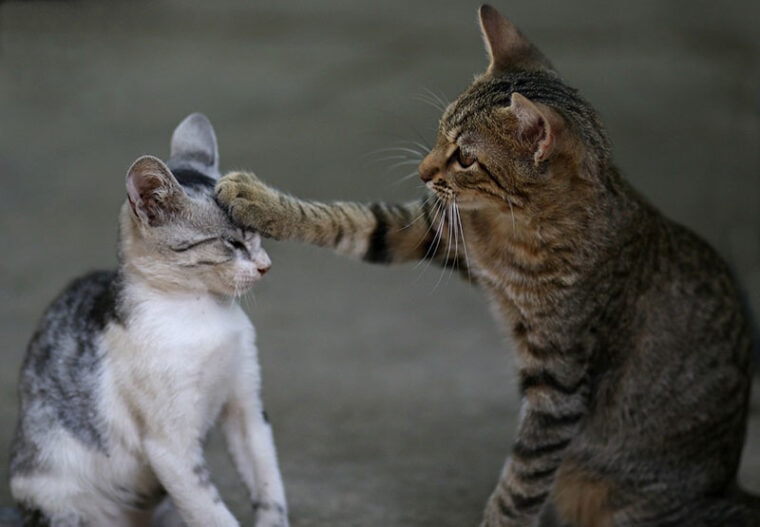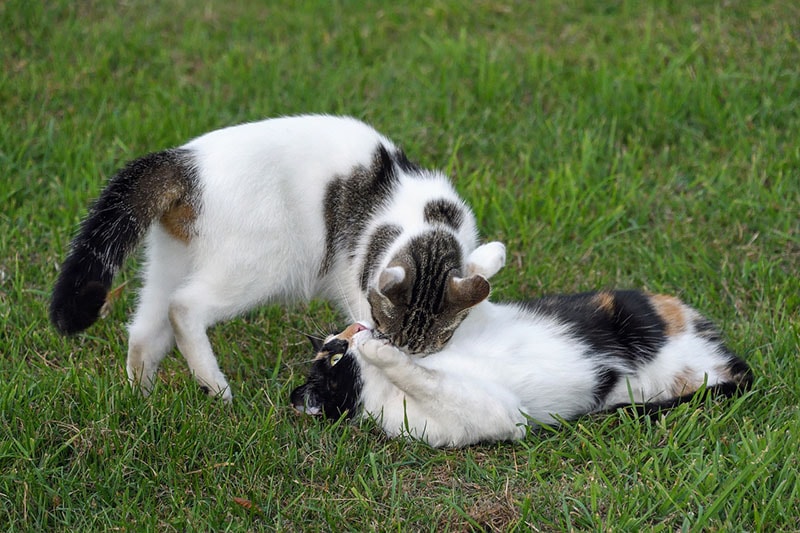
Older cats and younger kittens benefit from playing. It enables them to develop, perfect, and practice essential skills, and it also allows them to burn off energy while providing mental stimulation.
If you have two or more cats, their playing together can help form a bond while keeping them both entertained. However, general play can turn rough, and you need to be able to recognize the difference between positive play and rough play. If you notice aggression signs, use a toy wand or another toy and get their attention away from one another.
Read on to determine when your cats are playing too rough and what steps you can take to stop it.
First of All – Why Cats Play
Cats enjoy both solitary play and social play. Solitary play is when a cat plays with items and toys. This includes those times when they find items around the house and throw and catch them, and also when they pounce on their toy mice. They might partake in solitary play to help hone their skills relieve boredom or burn off energy.
Social play occurs when a cat plays with another cat, another pet in the house, or with you or other humans. Although social play tends to start when cats are young, it can progress and continue as cats get older. Social playing can look like fighting. It can involve scratching, kicking, rolling around together, and possibly even some biting.

Signs That Playtime Got Too Rough
While playtime is natural for cats of all ages, and it can involve multiple cats of different ages, there may come a point where playing turns to fighting. There are several signs to watch for that might indicate that play has turned into rough aggression.
Cats cannot speak, but their body language can tell us a lot about a situation and how they are feeling. Pay particular attention to your cat’s ears. If a cat’s ears are upright or pointing forward, likely, that the cat is still playing and not being aggressive. If the ears are back, this can be a sign of more serious fighting.
The tail is another good indicator. A wagging or swishing tail does not necessarily indicate that a fight is getting serious. But if the tail is puffed up, that is a sign of fear or aggression.
Also, look at how the cats are interacting with one another. In most play instances, cats will take turns to be “the aggressor,” so one of your cats will be on top before they swap positions and the top cat is now on the bottom. If one cat continues to dominate by being on top, this may be a sign of dominance.
How to Stop It
Direct intervention isn’t the best solution if your cats are getting rough. It can heighten tension between the pair and may lead to greater problems further down the line. Do not get in between cats that are fighting and do not pick one up to drag it away.
Instead, you need to try and drag their attention away from the situation. Use a cat toy, like a toy wand, that will get their attention. Encourage them to play with the toy rather than fighting, and let the tension diffuse.
How to Encourage Positive Play
There are several possible causes of rough play. Your cats could have a lot of pent-up energy that boils over and causes aggression. Ensure that you provide plenty of healthy playtimes every day.
Ideally, you should spend at least 20–30 minutes playing with each cat. If the cats will play nicely with you at the same time, you can interact with three-way social play. Otherwise, give each one some time playing with you.
If the situation has gotten really bad and the cats can’t be in the same room as one another for any period, you may need to separate them and try reintroducing them in the same way you did when you brought the new cat into the house.
Have them on opposite sides of a closed door so they can get used to one another’s smell. When they calmly sense the other cat’s presence, you can start gradual introductions. Ensure early visits are supervised and only allow them in the same room together when you are confident that they are comfortable with each other’s company.
Regular play sessions can help your cat stay happy and healthy. Why not start the play with a fun toy like Hepper's Catnip Stick Toy? These sturdy toys are double-bagged, bite-proof, and filled with 100% organic catnip. Choose your favorite pastel color and treat your cat to hours of fun!
At Pet Keen, we've admired Hepper for many years, and decided to take a controlling ownership interest so that we could benefit from the outstanding designs of this cool cat company!
Conclusion
Cats play together frequently, and unless this turns to aggressive play, it is not only natural but beneficial for the cats involved. However, such playtime can get serious and may turn aggressive.
Consider the context and how the cats interact when they’re not fighting and look at their body language when they are. This will help determine whether they are still playing and will enable you to determine when they have started fighting. Don’t directly intervene but use a toy wand or another toy and get their attention away from one another.
Featured Image Credit By: Dina Voicu, Pixabay







